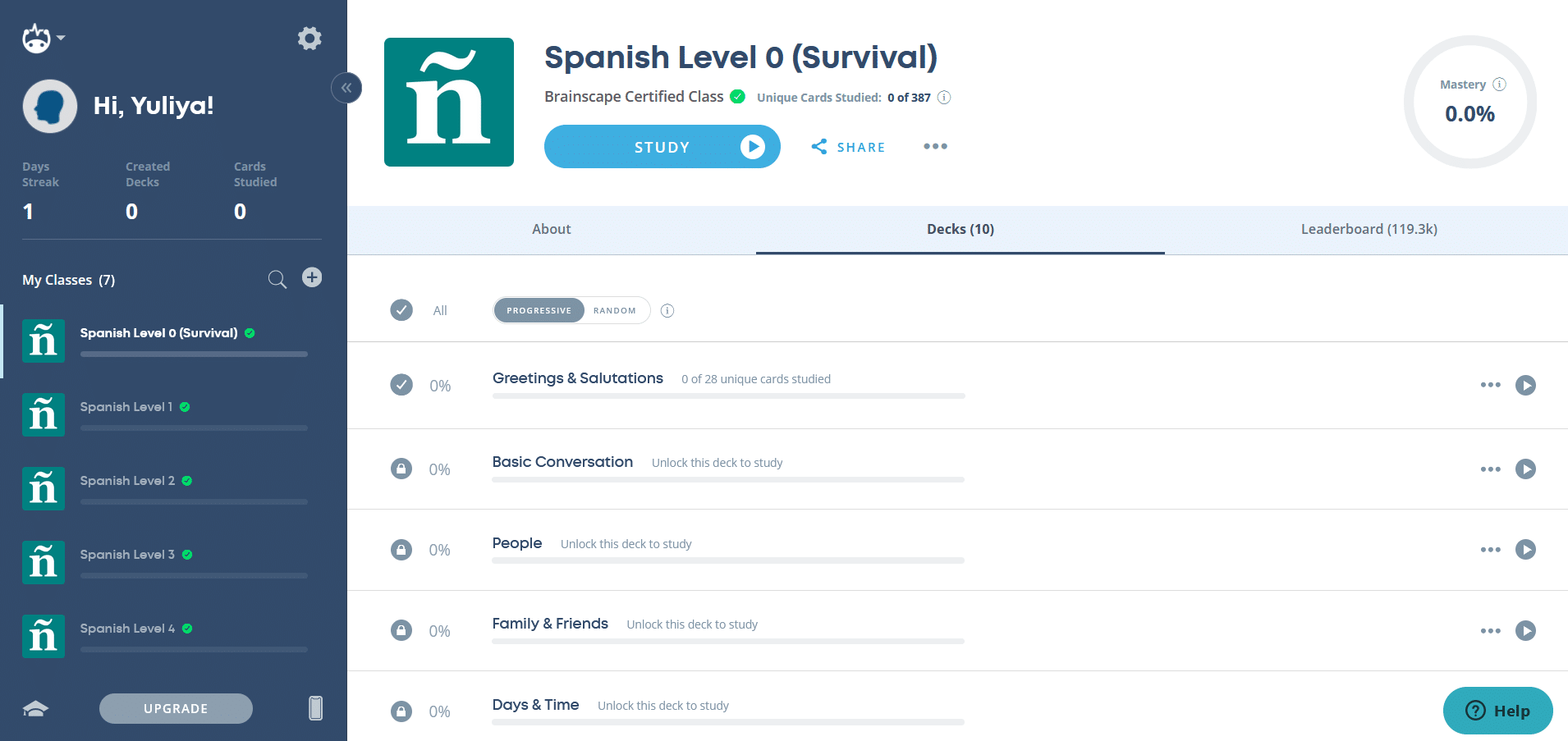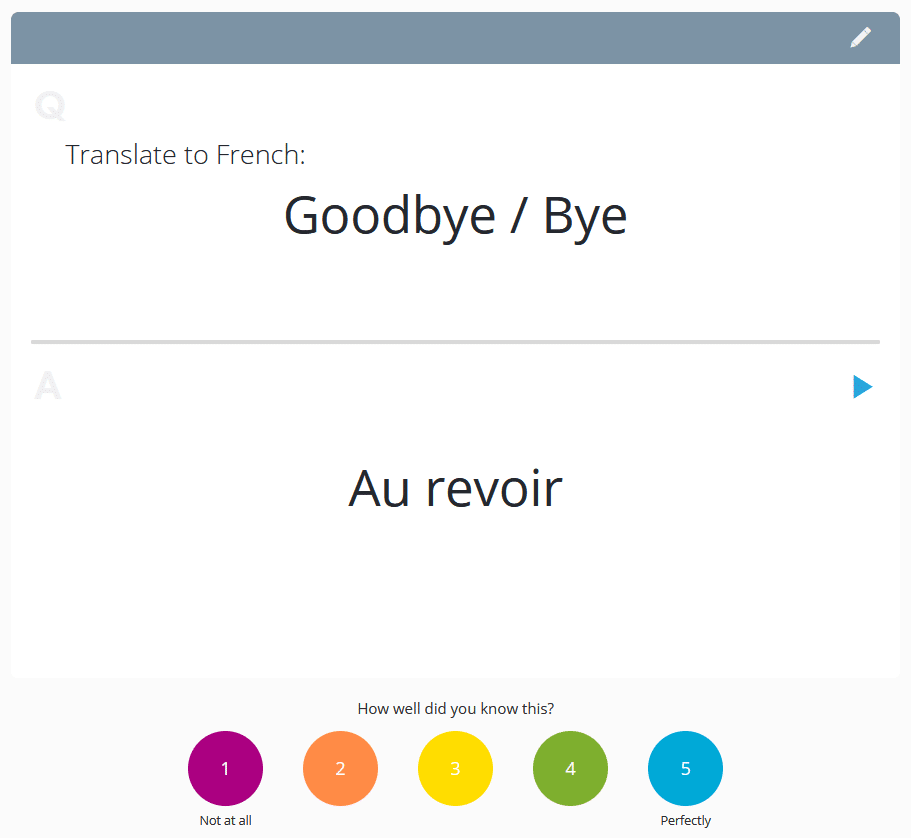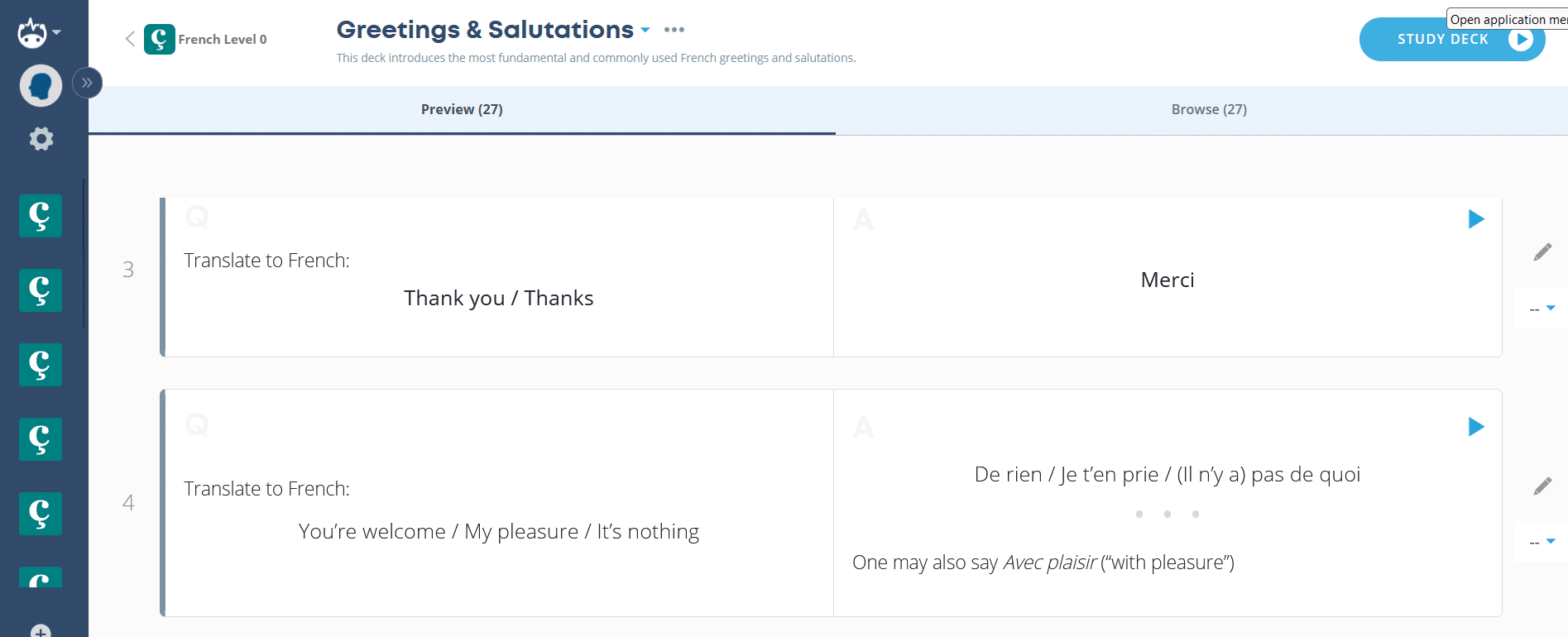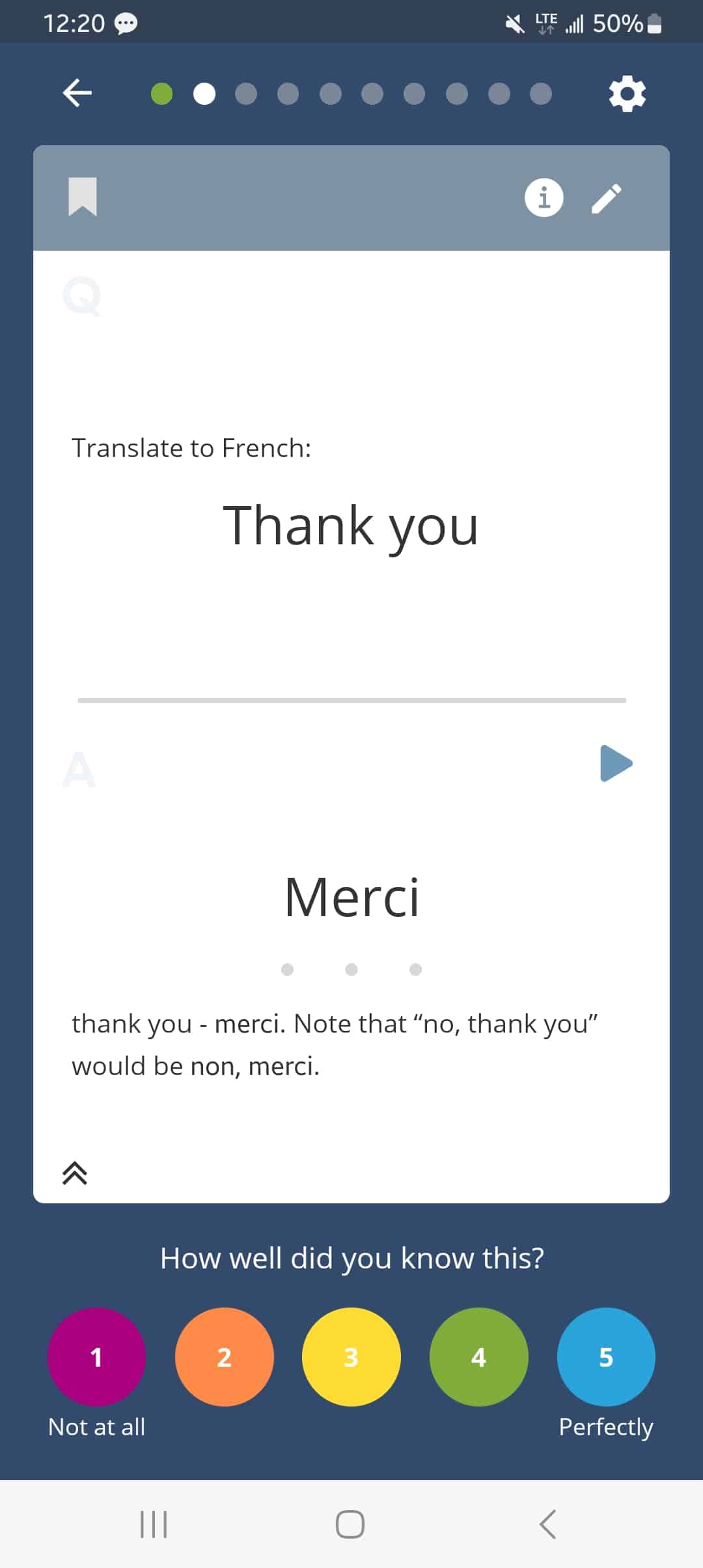
Brainscape Review: Shallow But Abundant Flashcard Language Courses
Brainscape is a popular language learning program that hopes to get you learning with flashcards.
In a nutshell, I found the app to be extensive, with a huge amount of content to study. However, the flashcards weren’t as detailed as I would have liked, and the monthly fee felt too high for what you get.
The program is worth checking out, though, especially if you’re looking to make your own flashcards and want a simple-to-use interface.
Overview
Name: Brainscape
Description: A learning program centered around flashcards.
Languages offered: Official courses in Chinese, French, Spanish, the JLPT N5 (Japanese language test) and Medical Spanish, and user-created content for many other languages, from Russian and German to Pashto, Dutch and Burmese.
Offer price: Some features available for free; $19.99 per month. $59.94 for 6 months, $95.88 for 12 months or $199.99 for lifetime access
Summary
Brainscape is a language learning program that uses flashcards to teach languages. The program features many user-created and some expert-made language courses made up of organized decks. However, the flashcards to be too shallow, typically only covering the definition of the word, without grammar or visual aids. The program is worth checking out, though, especially if you’re looking to make your own flashcards and want a simple-to-use interface.
- User friendliness - 7/107/10
- Delivers on promises - 6/106/10
- Authenticity - 7/107/10
- Value for price - 5/105/10
Pros
- A large number of flashcard decks and classes available
- Allows users to create customizable flashcards
- “Confidence Scale” provides a visual representation of your growth
- Clean and crisp app experience
Cons
- Only a small number of expert-created classes
- Flashcards don’t have nearly enough information for true learning
- High monthly fee relative to content received
Contents
- About Brainscape
- Brainscape Features
- Brainscape Free vs Pro
- Alternatives to Brainscape
- And One More Thing...
Download: This blog post is available as a convenient and portable PDF that you can take anywhere. Click here to get a copy. (Download)
About Brainscape
Brainscape was created in 2010 by Andrew Cohen, who found the language learning programs on the market at the time to be lacking. He decided to share his flashcard-based methods of learning with others, and Brainscape was born.
The program is a web and mobile platform designed to help people learn and retain information through adaptive flashcards. You can learn many topics on Brainscape, including everything from science and math to driving test review and wine appreciation. For the purpose of this post, I’ll be looking only at the foreign languages branch of the program.
Brainscape allows users to study with pre-crafted flashcard decks, or to create their own. The program then uses a spaced repetition system (SRS) to determine the optimal time intervals for revisiting flashcards, aiming to improve the long-term memorization of each new vocab.
Overall, Brainscape positions itself as a more advanced alternative to traditional flashcards, relying on smart repetition and science to teach new vocabulary.
Brainscape Features
Lots of expert- and user-created flashcard decks
Just to see how Brainscape works, I tried learning French, which I’m a complete beginner at. The French course is “Brainscape Certified,” which means that it was created by Brainscape and its content partners, not by regular users. Unlike user-generated content, these certified classes are checked for accuracy by real people, though the French page doesn’t reveal who, exactly, does the checking.
The French program has 124 decks containing a total of 15,534 flashcards. If this weren’t enough for me, I could also make my own flashcards.
I can also turn to the user-created content, of which there is a huge amount of. Much of the user-generated decks are just as good as the certified courses, with the added benefit that you can see who created them and check out more of their content.
Brainscape has certified courses for Chinese, French, Spanish, the JLPT N5 (Japanese language test) and medical Spanish but there are also decks or many different languages, including common options like Russian and German, and less commonly taught languages like Pashto, Dutch, Burmese, Yiddish and more.
Simple flashcard experience
Brainscape organizes its content into classes, which are further divided into decks. Each deck has a number of cards (the French course I was following had between 60 and 130 vocabulary words per deck).
For each deck, you can preview or browse the flashcards before you start learning. “Preview” shows you the complete list of flashcards in the deck, while “Browse” shows you each individual flashcard one by one.
Each flashcard supports a number of media formats, including text, images, sounds and video—though you need a Pro Subscription to add media.
When you’re making a new class or deck, you can choose whether you’re teaching or studying. Either way, you can share any deck you create with anyone you want, so you can study together.
I tried making a few of my own flashcards and found the experience to be super straightforward and simple. Each part of the flashcard making interface is clearly labeled and you can toggle between the basic and advanced editor for a bit more customization. Adding new vocab cards was a breeze, and I was studying my flashcards before too long.
Spaced repetition learning based on “brain science”
Brainscape uses spaced repetition but it calls it “Brainscape’s Confidence-Based Repetition” (CBR). The program claims that it helps you learn faster, because of what the program refers to as “brain science.”
Once you’re ready to start learning, you can dive right in. You can choose to move through each deck in order (“Progressive”) or mix in all the decks in each class (“Random”).
You’re shown the English translation first, then you click to reveal the French (or your target language). You then rate each word on how well you knew it on a scale from one to five. Words that you know well will be shown less frequently, while ones that you don’t will be shown more often.
As you learn, you can watch your level of confidence increase, literally: The “Confidence Scale” shows you the net change in your level of confidence for the round. In other words, it marks how much better overall you understand the words you’re studying.
At first, I was rating everything low, but the more I saw them, the more familiar I became with the words. It was pretty encouraging to watch the scale gradually rise, and I appreciate the visual indication of how much I improved in each round.
Not enough information for contextual learning to occur
While I did see myself start to recognize some words just from sheer repetition, I don’t feel that I’d be able to use any of these new words in conversation.
That’s because the flashcards generally contain just words in isolation. The certified courses also included audio for most of the words as well as example sentences and very basic usage notes for a few of them but, overall, the Brainscape learning program doesn’t have any contextual learning.
Aside from the certified decks, none of the Brainscape decks that I checked out had audio and none (including the certified ones) had IPA or even phonetic pronunciation. Example sentences, when they’re included, also don’t come with audio or a pronunciation guide. Additionally, there are no parts of speech or grammar info included in any of the flashcards that I looked at.
Flashcards are, of course, only what you make of them. Brainscape does equip users with the tools to make robust flashcards, complete with audio, images and additional notes. It seems that most of the foreign language decks don’t make use of these tools. While this is understandable for user-created decks (since a lot of the features are stored behind a paywall), I expected to see all the features fully utilized in the certified courses.
This was especially noticeable when the program told me that I could “learn four years’ worth of French in just a few months with Brainscape’s smart flashcards” when I started the French class. All the vocabulary in the world won’t do me much good if I can’t actually use it.
Clean app experience
Brainscape’s app version lets you continue your studies on the go. The simple, no-frills user interface is well-optimized for mobile.
I actually found the organization easier to follow on the app—while in the desktop version, I was constantly getting lost looking for the right decks, the mobile app makes it easy to jump right back into any part of your studies.
Flashcards take up the whole screen, which makes for a distraction-free experience.
Brainscape Free vs Pro
Some features of Brainscape are available for free, but to get the most from the program, you’ll need to get a paid subscription.
With a free account, you can make as many of your own flashcards as you want, and study your own flashcards indefinitely. You also have access to the first two decks of any class, but the rest are locked (yes, even classes created by other users).
The pro version is fairly steep, considering what you’re getting, with the basic subscription setting you back $19.99 monthly.
A subscription nets you access to:
- Unlimited flashcards
- All the flashcard-making features like adding audio and images, and ability to make your classes invite-only
- The ability to bookmark and make copies of flashcards
- The option to flip your flashcards, showing you the “back” before the front
- A peek at other people’s stats and the chance to reset your own
While these features are great, I’m not sure if they’re worth the monthly fee.
Alternatives to Brainscape
Brainscape is just one flashcard app among many. How does it stack up against other well-known flashcard apps? Is it really the “best” flashcard app, as it claims to be? Let’s take a quick look at how Brainscape compares to some other popular options!
Brainscape vs Anki
Anki is an immensely popular flashcard app, especially with Japanese language learners. It’s a very powerful program, with tons of customization options. You can change everything from the font size, customize the card background and even attach images and videos to them.
In fact, the immense versatility of the program can make it intimidating for beginners. Choose Brainscape if you want something easy and simple to use, but opt for Anki if you want to be able to customize every aspect of your cards—and all for free.
Brainscape vs FluentU
FluentU has flashcards integrated into its authentic-media- based learning program.
FluentU takes authentic videos—like music videos, movie trailers, news and inspiring talks—and turns them into personalized language learning lessons.
You can try FluentU for free for 2 weeks. Check out the website or download the iOS app or Android app.
P.S. Click here to take advantage of our current sale! (Expires at the end of this month.)

Like Brainscape, FluentU’s flashcards are based on spaced repetition. Unlike Brainscape, they also come with full audio pronunciation, example sentences and even clips from other FluentU videos where the word appears. The video-based learning enhances understanding by teaching languages in context.
FluentU’s quizzes also integrate video clips and provide you with opportunities to read, hear, write and even speak each vocabulary word you’re studying.
Brainscape vs Quizlet
Quizlet’s flashcard program is entirely user-made, so quality varies widely. However, its community is enormous (over 300 million users as of this writing) and there’s a ton of excellent content to be found among them.
The program is also embracing current technologies and has made flashcard creation easier thanks to AI integration. The AI aspect of Quizlet will also help you outline an essay, generate quick summaries of what you’re learning, get help from a virtual AI tutor and more.
Quizlet has a few other features that make it even more useful, like complete access to textbook chapters and vocab, and flashcards created by some familiar names, like Busuu.
Brainscape is a treasure trove of flashcards, with plenty of content ready for you to explore. It’s not the most detailed flashcard experience out there, but it’s a good option for anyone looking to make their own cards quickly and easily. There’s plenty of content to explore, so check it out if it sounds like something that’s right for you!
And One More Thing...
If you dig the idea of learning on your own time from the comfort of your smart device with real-life authentic language content, you'll love using FluentU.
With FluentU, you'll learn real languages—as they're spoken by native speakers. FluentU has a wide variety of videos as you can see here:
FluentU has interactive captions that let you tap on any word to see an image, definition, audio and useful examples. Now native language content is within reach with interactive transcripts.
Didn't catch something? Go back and listen again. Missed a word? Hover your mouse over the subtitles to instantly view definitions.
You can learn all the vocabulary in any video with FluentU's "learn mode." Swipe left or right to see more examples for the word you’re learning.
And FluentU always keeps track of vocabulary that you’re learning. It gives you extra practice with difficult words—and reminds you when it’s time to review what you’ve learned. You get a truly personalized experience.
Start using the FluentU website on your computer or tablet or, better yet, download the FluentU app from the iTunes or Google Play store. Click here to take advantage of our current sale! (Expires at the end of this month.)










